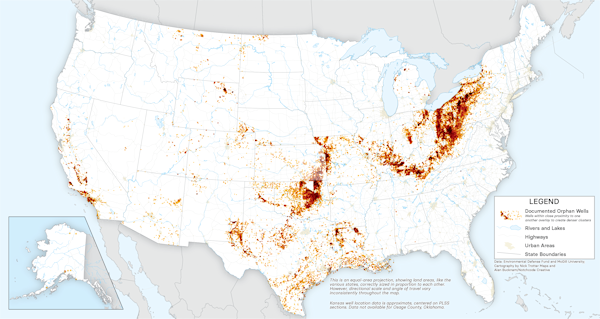SEJournal Online is the digital news magazine of the Society of Environmental Journalists. Learn more about SEJournal Online, including submission, subscription and advertising information.
 |
| The United States has roughly 117,000 oil and gas wells that are documented as being inactive, unplugged and with no solvent owner of record, as shown in the map above. There may be as many as 3.4 million undocumented orphan wells. Photo: Environmental Defense Fund. |
Reporter’s Toolbox: Will Thousands of Orphan Wells Be Safely Plugged?
By Joseph A. Davis
Plugging orphan wells is a worthwhile, and overdue, environmental project. Over many decades, oil and gas drillers have pumped them almost dry and abandoned them when they became too unproductive to make money. The problem is that some continue to leak methane and threaten the aquifers that people drink from.
Drillers today are supposed to give guarantees that
that they will decommission wells once done with them.
But the drillers who finished decades ago often
left town with no forwarding address.
Drillers today are supposed to give guarantees that they will decommission wells once done with them. But the drillers who finished decades ago often left town with no forwarding address. Fortunately the “Bipartisan Infrastructure Law” signed into law in 2021 bankrolled cleanup to the tune of $4.7 billion.
For environmental reporters, it’s a story. And for those of you who want to track this activity, you’ll be happy to learn there’s a database for that. Actually several.
The good news for data reporting geeks is that there are roughly 117,000 wells in the database. The bad news is that there may be as many as 3.4 million undocumented wells.
Where the data come from
There are about 27 states with a significant number of abandoned wells. Ultimately, most of this well info comes from the states, each of which has its own way of recording and listing old wells.
The U.S. Geological Survey, or USGS, maintains a database called the United States Documented Unplugged Orphaned Oil and Gas Well Dataset.
The Environmental Defense Fund, a nonprofit conservation group, has another database, which looks similar to the USGS one. EDF reworked the data from state sources. Its presentation emphasizes a state-by-state mapping of the wells.
Both datasets are fairly well documented and downloadable online. The problems are in the incompleteness and inconsistency of state data.
How to use the data smartly
If you look at the maps, you can see that the abandoned wells are distributed across the United States in a distinct pattern. There are a lot in Pennsylvania, where the first well was drilled in 1859, and Oklahoma. (Don’t forget there are also lots of abandoned wells in Canada, where the Parliamentary Budget Officer estimates clean-up costs will reach 1.1 billion Canadian dollars [US$0.8 billion] by 2025.)
How you use the data depends on what kind of story you are writing. Is it about jobs for local well crews? Drinking water well pollution? Current bonding rules? As with almost all data journalism, a lot of shoe-leather and ground-truth reporting is just as important as the data.
One big problem is that you may not be able to draw strong generalizations on some questions from these databases because they are skewed in many ways. At least the data document how incomplete the documentation is.
If you plan to crunch data on oil and gas wells, you will want to learn about API numbers. Those are unique identifiers for wells assigned under a system originated by the American Petroleum Institute (now run by a private contractor). The numerical system and its precursors go back to the 1950s. That’s a long time in oil-well years.
Joseph A. Davis is a freelance writer/editor in Washington, D.C. who has been writing about the environment since 1976. He writes SEJournal Online's TipSheet, Reporter's Toolbox and Issue Backgrounder, and curates SEJ's weekday news headlines service EJToday and @EJTodayNews. Davis also directs SEJ's Freedom of Information Project and writes the WatchDog opinion column.
* From the weekly news magazine SEJournal Online, Vol. 8, No. 10. Content from each new issue of SEJournal Online is available to the public via the SEJournal Online main page. Subscribe to the e-newsletter here. And see past issues of the SEJournal archived here.













 Advertisement
Advertisement 



